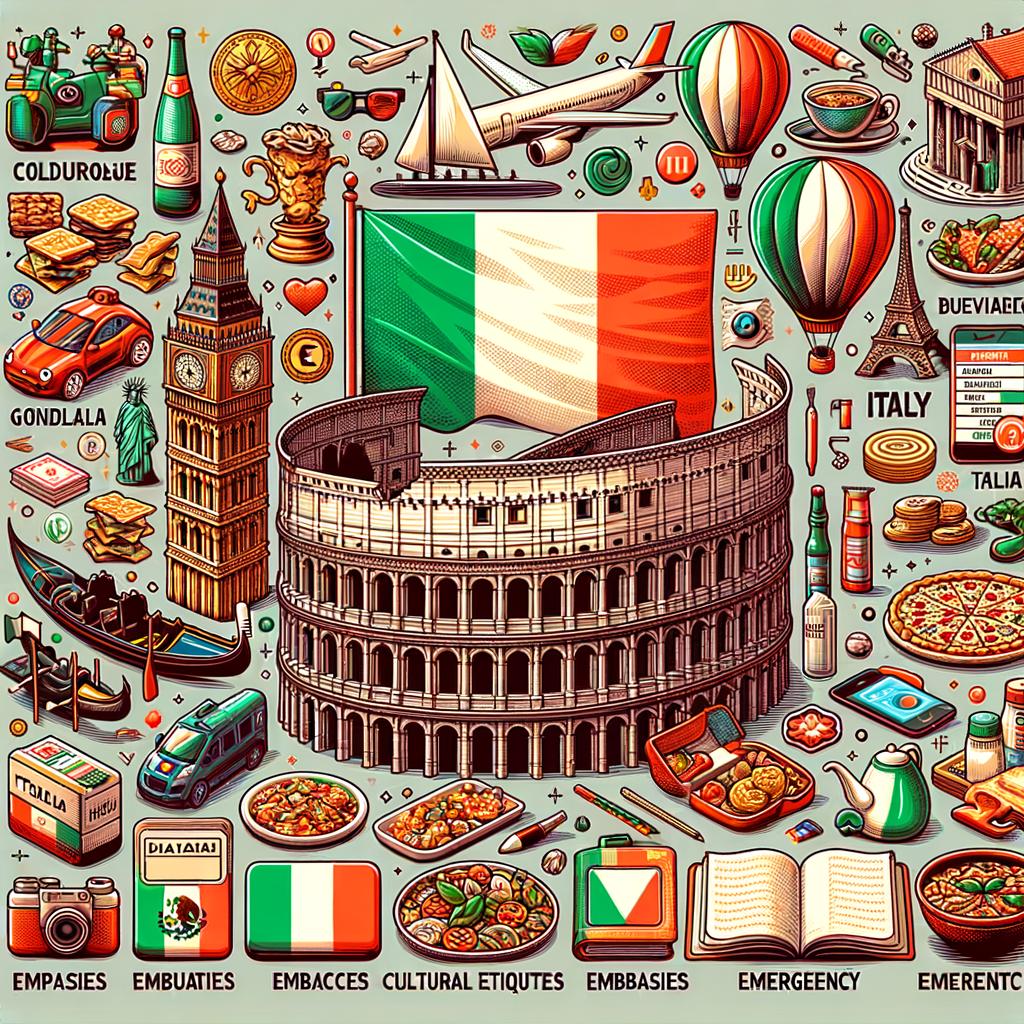What do I need to know before traveling to Italy? Italy is a country in Southern Europe known for its rich history, art, culture, and cuisine, making it a must-visit destination for travelers around the world.
From the iconic landmarks of Rome to the picturesque canals of Venice and the stunning coastline of the Amalfi Coast, Italy offers something for every type of traveler. Before packing your bags and jetting off to this enchanting country, there are several important factors to consider to ensure a smooth and enjoyable trip.
First and foremost, it’s essential to be aware of the visa and passport requirements for traveling to Italy. Understanding the necessary documentation and entry regulations will help prevent any unexpected travel hiccups. Additionally, familiarizing yourself with Italian customs and culture will not only enrich your experience but also ensure that you show respect towards the local traditions.
In this article, we will delve into all the crucial information you need to know before embarking on your journey to Italy. From visa requirements and packing essentials to understanding Italian culture and navigating transportation, we’ll cover all aspects of planning a trip to this captivating country.
Whether you’re a first-time visitor or a seasoned traveler, these insights will help you make the most of your time in Italy. So sit back, relax and let us guide you through everything you need to know before traveling to Italy.
Visa and Passport Requirements for Traveling to Italy
Traveling to Italy is an exciting prospect, but before you pack your bags, it’s crucial to understand the visa and passport requirements for entering the country. For U.S. citizens, Italy is part of the Schengen Agreement, which means tourists can enter for up to 90 days within a 180-day period without a visa. However, there are still specific passport requirements that must be met.
To enter Italy, your passport must be valid for at least three months beyond your planned departure date. It’s also important to have at least two blank pages in your passport for entry stamps. If you plan to visit other countries in Europe during your trip, make sure to check their specific visa and passport requirements as well.
If you are not a U.S. citizen or if you plan to stay in Italy for longer than 90 days, it’s essential to check with the Italian embassy or consulate in your home country regarding visa requirements. Each country has its own set of rules and regulations, so it’s important to do thorough research and ensure that you have all the necessary documentation before traveling to Italy.
Packing Essentials
When preparing for a trip to Italy, it’s important to pack wisely in order to ensure a comfortable and enjoyable experience. Here are some essentials to consider bringing with you:
- Comfortable walking shoes: Italy is known for its cobblestone streets and uneven terrain, so be sure to pack comfortable walking shoes to explore the cities and towns.
- Appropriate attire: Italians are known for their stylish fashion sense, so be sure to pack clothes that are fashionable yet modest. Bring layers for varying temperatures, especially if you plan on visiting different regions of the country.
- Travel adapter and converter: Italy uses type F electrical outlets, so be sure to bring a travel adapter and converter if your devices are not compatible.
- Travel insurance: It’s always wise to have travel insurance when traveling abroad. This can provide peace of mind in case of any unexpected emergencies or incidents during your trip.
Taking these packing essentials into consideration can help ensure a smooth and enjoyable trip to Italy.
Additionally, it’s important to be mindful of the local customs and culture when visiting Italy. Italians take great pride in their heritage and traditions, so respecting their way of life is essential. Familiarizing yourself with Italian customs such as greetings, dining etiquette, and social norms can go a long way in making a positive impression during your visit.
Lastly, make sure to check the weather forecast for the specific regions you plan on visiting in Italy. This will help you pack accordingly and be prepared for any climate variations during your travels.What do i need to know before traveling to italy.
Understanding Italian Culture and Customs
Italy is a country rich in history, art, and culture, making it a must-visit destination for travelers from all around the world. However, before traveling to Italy, it’s important to have a basic understanding of Italian culture and customs to ensure an enjoyable and respectful experience during your trip.
Greetings and Personal Space
In Italy, greetings are an important part of social interaction. It is customary to greet people with a handshake, especially when meeting someone for the first time. Additionally, Italians are known for their affectionate nature and may greet friends and family with kisses on the cheek. When conversing with Italians, it’s also important to be mindful of personal space as they tend to stand closer during conversations compared to other cultures.
Dress Code and Fashion
Italian fashion is renowned worldwide, and locals take pride in their appearance. When visiting churches or religious sites, it’s important to dress modestly by covering shoulders and knees. In general, Italians are stylish dressers and tend to favor elegant and sophisticated attire.
Appreciating Italian Cuisine
Food is an integral part of Italian culture, and meals are seen as a time for bringing people together. When dining out at restaurants, it’s customary to linger over meals rather than rushing through them. Additionally, be mindful of traditional Italian dining etiquette such as not ordering a cappuccino after midday or asking for parmesan cheese on seafood dishes.
By familiarizing yourself with these aspects of Italian culture and customs before your trip, you can ensure that you have a fulfilling experience while showing respect for the local traditions. Understanding these cultural nuances will allow you to immerse yourself in the beauty of Italy while also forging meaningful connections with the locals.
Must-See Attractions in Italy
Italy is a country that boasts a rich cultural heritage and stunning natural landscapes, making it a must-visit destination for travelers from around the world. Whether you’re interested in exploring ancient ruins, admiring Renaissance art, or simply enjoying the breathtaking scenery, Italy has something to offer for every type of traveler.
Top Cities to Visit
When visiting Italy, be sure to include some of its top cities on your itinerary. Rome, the capital city, is home to iconic landmarks such as the Colosseum, Vatican City, and the Trevi Fountain. Florence, known as the birthplace of the Renaissance, is famous for its art and architecture, including Michelangelo’s David and the Uffizi Gallery.
Venice, with its network of canals and stunning palaces, offers a unique and romantic atmosphere for visitors. Other cities worth exploring include Milan, known for its fashion and design scene, and Naples, which offers access to Pompeii and Mount Vesuvius.
Landmarks Not to Miss
In addition to its cities, Italy is home to numerous landmarks that are not to be missed. The Leaning Tower of Pisa is an iconic symbol of Italy and offers a unique photo opportunity. The ancient city of Pompeii provides insight into Roman life before it was buried under volcanic ash.
The Amalfi Coast offers breathtaking views of coastal cliffs and colorful villages perched on hillsides. And of course, no trip to Italy is complete without visiting the iconic leaning tower in Pisa.
Planning Your Itinerary
As you plan your trip to Italy, be sure to research each city and landmark you wish to visit in order to make the most of your time there. Consider purchasing skip-the-line tickets for popular attractions or booking guided tours for a more immersive experience. Planning your itinerary ahead of time will ensure that you don’t miss out on any must-see sights during your visit.
By familiarizing yourself with these top cities and landmarks in Italy before your trip, you can ensure that you make the most of your time in this beautiful country.
Essential Italian Phrases and Words to Know Before Your Trip
Before embarking on your trip to Italy, it’s essential to familiarize yourself with some basic Italian phrases and words that will greatly enhance your travel experience. While many Italians do speak English, especially in tourist areas, making an effort to communicate in the local language shows respect and can help bridge cultural differences. Knowing a few key phrases can also be incredibly helpful when navigating transportation, ordering food at local restaurants, and seeking assistance from locals.
Expressing gratitude is always appreciated, whether you’re receiving directions from a local or enjoying a delicious meal at a trattoria. Additionally, knowing how to ask for help or directions can be invaluable. The phrase “Excuse me, where is ” translates to “Mi scusi, dov’è ” and can come in handy when navigating the streets of Italian cities.
Learning these basic Italian phrases will not only show respect for the local culture but will also make your travels much smoother and more enriching. With these essential words in your repertoire, you’ll be better equipped to immerse yourself in the beauty of Italy and connect with its people on a deeper level. So before packing your bags for Italy, take some time to learn these fundamental phrases – it will enhance your travel experience in countless ways.
Navigating Transportation in Italy
Italy is a country with a well-established transportation system that makes it relatively easy for travelers to get around. Whether you’re looking to explore the charming streets of Rome, hop between the islands of Venice, or relax on the Amalfi Coast, knowing how to navigate transportation in Italy is essential for a smooth and enjoyable trip.
To help you make the most of your time in Italy, here are some key tips for getting around:
1. Public Transportation: Italy offers an extensive public transportation network, including buses, trams, and trains. The country’s train system is particularly renowned for its efficiency and wide coverage. Whether you’re traveling between cities or exploring within a city, public transportation is often the best way to get around.
2. Renting a Car: If you prefer more flexibility in your travel itinerary, renting a car can be a great option for exploring Italy’s countryside and smaller towns. Keep in mind that driving in major cities like Rome and Florence can be hectic, so consider this when deciding whether to rent a car.
3. Walking and Cycling: Many Italian cities are pedestrian-friendly, with historic areas that are best explored on foot or by bicycle. Consider taking leisurely strolls along cobblestone streets or joining a guided cycling tour to immerse yourself in the local charm.
By familiarizing yourself with these transportation options and tips beforehand, you’ll be better prepared to navigate Italy and make the most of your travel experience. Whether it’s hopping on a train to visit iconic landmarks or meandering through picturesque villages by car, understanding how to get around will enhance your adventure in this captivating country.
Dining and Drinking in Italy
When traveling to Italy, one of the most exciting aspects is undoubtedly the opportunity to indulge in authentic Italian cuisine. Before you embark on your trip, it’s essential to familiarize yourself with the dining and drinking etiquette in Italy, as well as some culinary tips that will enhance your experience.
In Italy, dining is a social affair that is not rushed. It is customary to linger over a meal, savoring each course and enjoying the company of others. Additionally, it’s important to note that Italians take their food seriously, and certain dining customs should be observed. For example, it is considered impolite to ask for substitutions or modifications to a dish in a traditional Italian restaurant.
When it comes to ordering drinks in Italy, particularly coffee, there are specific customs to adhere to. For instance, ordering a cappuccino after 11 am is generally frowned upon as it is considered a breakfast drink. Instead, opt for an espresso or macchiato if you’re craving caffeine later in the day.
In addition to understanding dining etiquette, familiarizing yourself with Italian cuisine can greatly enhance your culinary experience while traveling in Italy. Each region of Italy boasts its own specialties and culinary traditions, so be sure to explore local dishes and flavors during your visit.
Whether it’s indulging in fresh seafood along the coast or sampling authentic Neapolitan pizza in Naples, immersing yourself in the diverse and rich culinary landscape of Italy is sure to be a highlight of your trip.
Overall, taking the time to learn about Italian dining customs and cuisine will not only ensure that you have an enjoyable dining experience but also show respect for the country’s culture and traditions.
Currency and Money Matters
When traveling to Italy, it’s important to familiarize yourself with the currency and money matters in order to have a smooth and hassle-free trip. The official currency of Italy is the Euro (EUR), and it is recommended to exchange your money before arriving in the country to avoid getting a lower exchange rate at airports or tourist areas.
It’s also a good idea to notify your bank of your travel plans to Italy, so they don’t flag any transactions as suspicious.
ATMs are widely available throughout major cities and towns in Italy, making it convenient for travelers to withdraw cash when needed. However, it’s important to be aware of any potential fees for using foreign ATMs or credit cards, so make sure to check with your bank beforehand. Additionally, always carry some cash on hand as there may be smaller establishments that do not accept credit cards.
When it comes to tipping in Italy, it is not mandatory but appreciated for exceptional service. In restaurants, a service charge may already be included in the bill, but if not, leaving a 10-15% tip is customary. For other services such as taxis and hotel staff, rounding up the bill or leaving a small tip is common practice.
Lastly, be cautious of pickpockets and keep an eye on your belongings, especially in crowded tourist areas or public transportation. Consider using a money belt or hidden pouch to store your valuables for extra security while exploring the beautiful sights of Italy.
Safety Tips for Traveling in Italy
In conclusion, traveling to Italy can be an enriching and rewarding experience, but it’s important to be prepared and informed before your trip. Understanding the visa and passport requirements, packing essentials, Italian culture and customs, must-see attractions, essential phrases, transportation options, dining etiquette, currency matters, and safety tips are all crucial aspects of planning a successful trip to Italy.
Before heading to Italy, it’s essential to familiarize yourself with the local customs and traditions while also being mindful of safety precautions. It’s advisable to stay aware of your surroundings, especially in crowded tourist areas where pickpocketing can occur. Additionally, staying updated on any travel advisories or local news can provide valuable insights into potential safety concerns within specific regions of the country.
By taking note of these important factors and doing your research before embarking on your journey to Italy, you can ensure a smooth and enjoyable experience. Whether you’re exploring the historic landmarks of Rome or indulging in the culinary delights of Florence, being well-prepared will allow you to fully immerse yourself in the beauty and charm of Italy while also staying safe throughout your travels.
So remember: What do I need to know before traveling to Italy? With thorough preparation and awareness, you can make the most out of your Italian adventure.
Frequently Asked Questions
What Do I Need Before Traveling to Italy?
Before traveling to Italy, it is important to have a valid passport and, depending on your nationality, possibly a visa. It is also a good idea to carry travel insurance, some local currency, and any necessary medications or prescriptions.
Can I Wear Jeans in Italy?
Yes, you can definitely wear jeans in Italy. They are a popular choice of clothing for both locals and tourists. However, keep in mind that Italians tend to dress more formally than some other cultures, so consider packing some nicer outfits as well.
Are There Any Travel Restrictions to Italy?
Currently, there are travel restrictions to Italy due to the COVID-19 pandemic. These restrictions may include testing or quarantine requirements for travelers arriving from certain countries or regions. It is important to check the latest travel advisories and guidelines before planning a trip to Italy.

I’m a passionate traveler, writer, and Italophile. My fascination with Italy’s history, art, and culture has led me on countless adventures across the Italian landscape. Through “I Live Italy,” I share my love for this extraordinary country and aims to inspire others to explore its boundless beauty.





